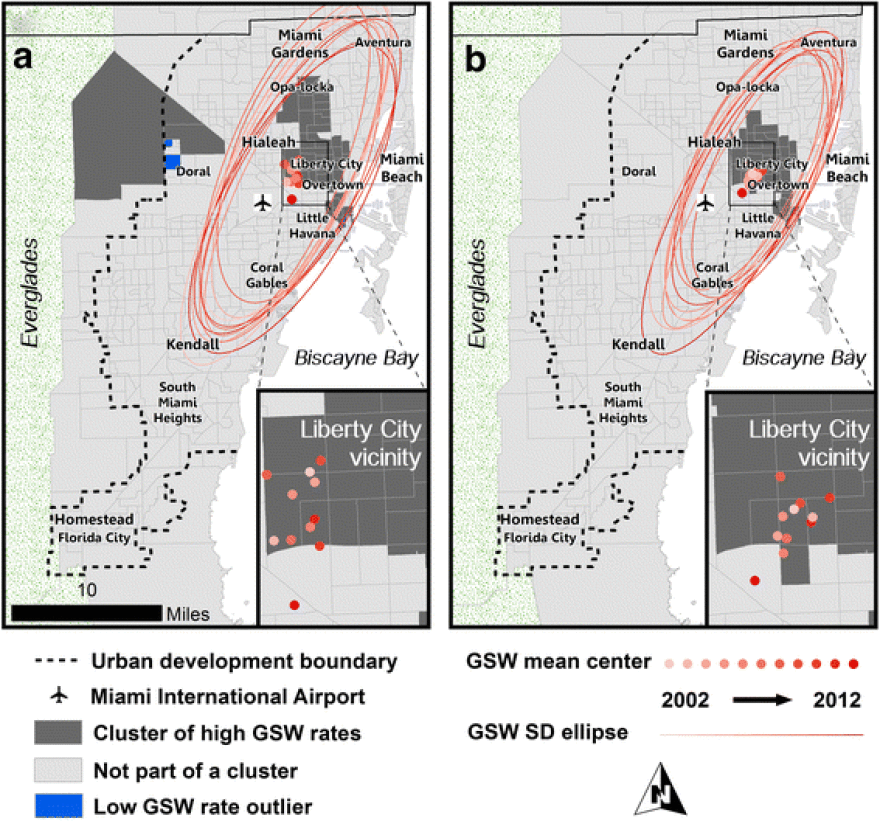Gun shot injuries in Miami-Dade County are largely happening in a cluster of neighborhoods and disproportionately affect young black men, according to a recent study.
The study looked at patients treated for intentional gunshot injuries at Jackson Memorial Hospital’s Ryder Trauma Center from 2002 to 2012.
Researchers with the University of Miami School of Medicine mapped the zip codes of gun shot injury patients by incident location and where the patient lives. Most victims are shot in their neighborhoods, which are typically predominantly black communities, according to the study.
Read more: Young Survivors, The Unspoken Trauma Of Gun Violence
It also found that while black people make up 19 percent of the population in Miami-Dade County, just over 70 percent of victims treated at Jackson for gunshot wounds were black males.
The researchers note that their needs to be more understanding about the role race, poverty and other social pressures play in neighborhoods with high rates of gun violence injuries when considering possible solutions.
"Targeted public health interventions by municipal— and state-level policy makers, starting with employment opportunities, economic inclusion, poverty reduction programs, and efforts to reduce structural racism, would likely have a significant county-wide public health impact," researchers wrote.
WLRN reporter Nadege Green spoke to one of the co-authors of the study, Dr. Tanya Zakrison, a trauma surgeon at Jackson. Below is an excerpt of their conversation:
This study looks at intentional gunshot injuries over a 10-year period in Miami-Dade. It maps out the address of where a person was shot and where that person lives. What did you find?
We found over that 10 or 11-year period, people are shot where they live and it's not a surprise because this is in keeping with the data that we've seen from other cities across the United States, where gun violence is disproportionately affecting poor communities of color.
"They're getting younger and the rate of gun violence is increasing over time and it's occurring in these poor neighborhoods."
So in Miami that means the bulk of the gun violence that we're seeing is disproportionately affecting black people, which includes African-American plus Haitian communities.
The age of people affected by gun violence is actually going down over time so they're getting younger and the rate of gun violence is increasing over time, and it's occurring in these poor neighborhoods.
And what's the most interesting and telling of this is that over an 11- year period nothing has changed. The violence hasn’t shifted to other neighborhoods or it hasn’t moved around the city. It's in the same small area of Miami, meaning there's an urgent need for political intervention to urgently address this issue.
Why did you do this study?
I did this study because I'm tired of operating on 16-year olds that come in shot. I'm tired of operating on people that are in the prime of their lives and they're the strongest and healthiest of their life and yet they come in shot.
Why hasn't anyone done this before in Miami-Dade? There isn't a lot of data around this issue.
Correct. For scientists such as myself, clinician scientists, surgeon scientists, for us to investigate any topic or any issue it’s difficult to do this unfunded. It is possible, but it’s challenging.
"I did this study because I'm tired of operating on 16-year olds that come in shot."
We need to look at this public health problem and deal with it as such. I think it's hard to find any trauma surgeon in Florida and specifically us here, at the Ryder Trauma Center in Miami-Dade County, who does not believe that gun violence is a public health issue.
There's disproportionate funding into diabetes, motor vehicle collisions. There's nothing on gun violence or very, very little.
This is a health study looking at information from patients who are rushed to the trauma center at Jackson Hospital, but as you start to peel back the information in the study it very quickly and clearly becomes a conversation about race.
I think what we're seeing is we're seeing a body count of black, African-American and Haitian young men.
This is a call to action. We've literally counted the number of people that have died prematurely in Miami-Dade County. And it's going up.
"Really there’s nothing normal about a 14-year-old or an 18-year-old - or anyone- getting shot actually."
And nothing's changed over at least 10 years. So it's a call to arms to say the structure of systemic discrimination that's been affecting mainly our African-American and Haitian populations, but additionally our Latin American populations in Miami-Dade County must change immediately.
What do you want to happen with this information?
I think now that we have data specific to Miami-Dade County we can no longer look at gun violence as if it's only a problem in Chicago, only a problem in Baltimore or elsewhere and that it doesn’t affect us.
Really there’s nothing normal about a 14-year old or and 18-year old - or anyone- getting shot actually.
But we’ve normalized the abnormal with these youth. We’re given these signals or these messages through TV, society through the media, through even our academic institutions that say, “Well, you know it is what it is.”
I'm hoping what we can glean from the study is -- look at all these preventable deaths that have occurred of our young people, young healthy people of Miami-Dade County. We have to urgently act now to prevent any more from occurring.






